Festivals are a time of great joy and celebration. Dussehra is no exception to this! As per the Hindu calendar, Dussehra falls on the Ashvina month (September-October in the English calendar) on Shukla Paksha (bright fortnight). Devotees eagerly await the pomp and festivities that mark the end of the nine-day-long Navarathri festival. Dussehra is a fitting end to the traditional rituals that were a highlight of the Navarathri festival that paid homage to the nine Navadurga manifestations of the Goddess Maa Durga.
Vijayadasami – Triumph Of Good Over Evil
As we all know, Navarathri starts on the day of Amavasya (new moon) and goes on for nine nights. It ends with the Dussehra festival on the 10th day. This festival is also called Vijayadasami. The term Vijayadasami is an amalgamation of two words: Vijaya means “victorious” while Dasami means “tenth”. Thus, when put together, this indicates that Vijayadasami is a festival that occurs on the tenth day to celebrate the victory of good over evil.
As stated earlier, the festival of Dussehra is known by many names. Vijayadasami, Dassara, and Dashain are all different names for Dussehra and it varies from region to region. Likewise, the rituals and festivities associated with this major Hindu festival are also different across the states of India.
Top 10s Only presents a brief look at the Top 10 Dussehra Celebrations In India. Read on to learn more about the Dussehra celebrations that take place in various parts of India.
List of Top 10 States That Celebrate Dussehra
Dussehra is the culmination of the nine-day Navarathri festival. It is celebrated by Hindus all over the world with great pomp and festivity. Different regions and cultures celebrate it in unique ways. Still, the essence remains the same – the triumph of good over evil.
1. Dussehra Celebrations In Rajasthan
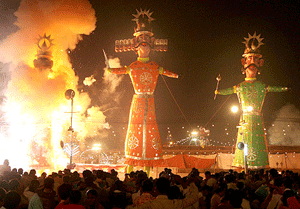
Aside from the Rajputana culture being followed, the people of Rajasthan religiously perform various festivals, and Dussehra is no exception. Rajasthan, known for arts and crafts, makes enormous effigies of about 75 feet of Ravana, Kumakaran and Meghanath. These are then decorated and placed on huge open grounds (maidans). On the Dussehra festival, huge crowds gather around these effigies and watch them being burnt. Dussehra fair is arranged on these grounds. Kids and adults enjoy their time and have fun. It is believed that seeing those burning effigies is auspicious and signifies the burning of bad habits.
2. Mysore Dasara Celebrations In Karnataka
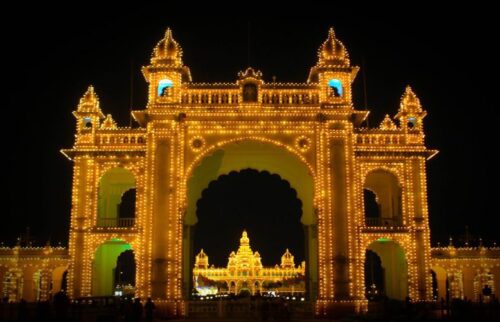
The Mysore Dasara is famous not just in Karnataka but all over India. It is inaugurated by the Royal family of Mysore on the first day of Navratri and concludes with the famous Jamboo Savari on Vijayadashmi. The entire city is decorated and all the 10 days are celebrated with much fanfare. On Vijayadashmi, beautifully decorated Elephants, horses and camels walk in procession around the main city streets and lakhs of people visit Mysore to witness this. It coincides with the Dussehra holidays in Karnataka and you can see local and foreign visitors come to watch the Jamboo Savari. The lead elephant is explicitly trained for months to carry the Chinnada Ambari or the Golden Howdah with Goddess Chamundeshwari. Cultural programs and fairs are hosted with the best talents performing in front of the Mysore Palace. The illuminated Mysore Palace, displayed every night during these ten days, is a sight to behold.
3. Golu, Saraswathi Pooja & Vijayadasami Celebrations In Tamil Nadu
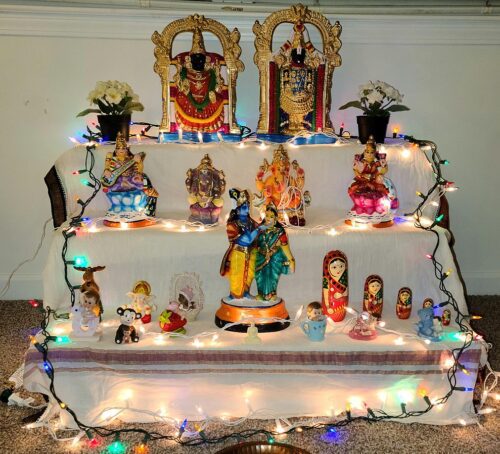
Tamil Nadu celebrates Vijayadasami differently when compared to most other places in India. While the rest of the country celebrates the death of Ravana, Tamil Nadu celebrates Saraswati, Durga and Lakshmi on this day. The nine days before Vijayadasami are dedicated to these three goddesses. Out of the nine days, three days each are devoted to Maa Lakshmi, Saraswati, and Durga. Golus or dolls are placed in the houses as Dussehra alankaram during these days. They are placed on stairs of 5, 7, 9 or 11 steps, with the topmost stair having dolls of these goddesses.
Among the many celebrations in Tamil Nadu, the Kulasekarapattinam Mutharamman is popular in that region. The Dasara celebrations here are next only to Mysore Dasara. On Vijayadasami, a drama depicting Mahishasura Mardini killing Mahisasura is performed. It is followed by the burning of crackers and dancing to celebrate the victory.
4. Goddess Bathukamma Celebrations In Andhra Pradesh & Telangana
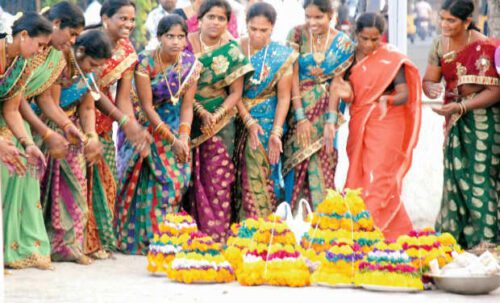
The Bathukamma festival is a unique Dussehra festival that is celebrated in Andhra Pradesh and Telangana. It is a nine-day-long festival with the final day coinciding with the Dussehra. The last day of the festival is called Saddula Bathukamma. Goddess Bathukamma is believed to be an incarnation of Goddess Sita and is prayed to. Women make idols of this goddess with seasonal flowers. Girls and women sing and dance around this idol. On the last day of the festival, the murti (idol) is taken to a lake or pond. It is then immersed in the water, much like the visarjan during the Ganesha Chathurthi.
5. Kullu Dussehra Celebrations In Himachal Pradesh
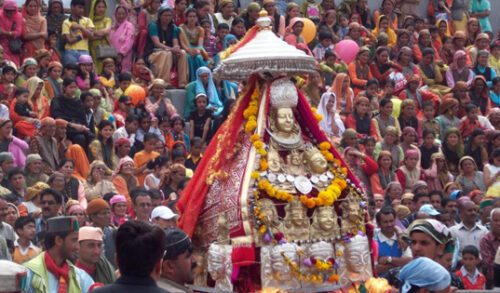
The Kullu Dussehra is celebrated differently when compared to other regions. The festival starts on Vijayadashami and is held for a week. It marks the victory of Lord Raghunath over Ravana. This festival is an important occasion for the people of this state with lakhs of people gathering at Dhalpur Maidan, which is the centre of all festivities.
On the first day of the festival, a huge statue of Lord Raghunath is placed on a beautiful chariot. The devotees offer prayers to this statue on all seven days along with other village deities. On the last day of the festival, sacrifices of lamb, buffalo, etc. are done by devotees. A bonfire is lit as part of Dussehra activity and the idol of Lord Raghunath is taken for a grand procession and then brought back. The bonfire signifies Ravana being killed and Lanka burning. Hence, it is also referred to as Lankadahan.
6. Durga Puja Celebrations In West Bengal
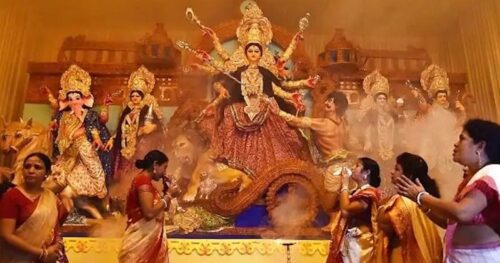
Durga Puja is among the most important days for a Bengali. The puja is performed for nine nights and ten days. The days start early and the nights are long and fun-filled. It is believed that Maa comes to visit her mother’s home from her husband’s place at this time every year. She is welcomed with much grandeur, just as any other daughter would be received at her mother’s house. Families are dressed in their finest and beautifully decorated idols are placed in every pandal with different themes. Pandal hopping is one of the most popular things, and pandals vie to get the maximum number of visitors. On the 10th day, the idol is taken in procession and immersed in water. After this, Bikoya is a tradition where families visit and greet each other and exchange presents and sweets.
7. Garba Celebrations In Gujarat
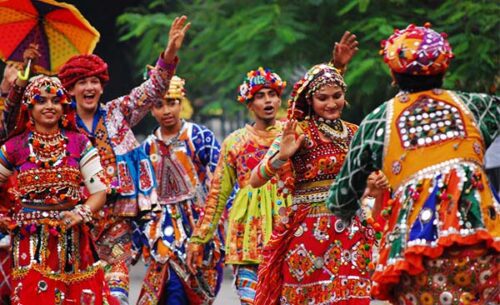
The term Navratri is not complete without mentioning the Garbha celebrations in Gujarat. All nine days are celebrated with great fervour as it is observed to commemorate all nine forms of Goddess Durga. The first three days are dedicated to Maa Durga, who destroys evil, the next three days are committed to Maa Lakshmi and the last three to Maa Saraswati, the goddess of wisdom and knowledge. On the tenth day, Vijayadashami is celebrated. Vehicles are decorated and puja is performed to seek blessings. It is also auspicious to buy new vehicles on this day. The best part of this festival is the Garba and Dandiya. Seeing people dress in gold and silk and dancing to great music is a beautiful sight that one should not miss.
8. Jagraata Celebrations In Punjab
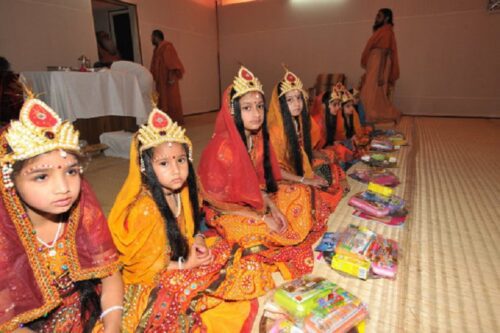
In Punjab, Dussehra is celebrated to honour Goddess Shakti. People fast for the first seven days of Navratri and on the seventh day perform Jagraata. It is a ritual of singing devotional songs praising gods and goddesses all night long. On Ashtami, the eighth day, the fast is broken by arranging a Kanjak. It is done to show gratitude to the Goddess. Nine young girls who have not yet hit puberty are invited and are considered the nine forms of Maa Durga. They are welcomed into the house by washing their feet. A red thread is tied around the wrists and a tika is applied to the forehead. Delicious Dussehra food and gifts are then given to them just as it is offered to Maa Durga herself.
9. Ramlila Celebrations In Delhi
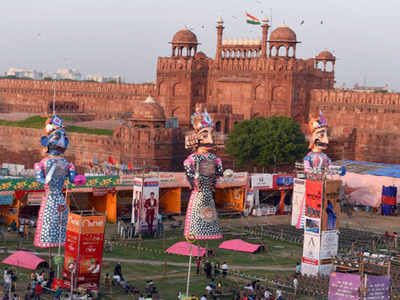
When it comes to celebrating Dussehra, Ramlila in Delhi is the most popular. The entire city is decorated beautifully. The favourite thing for people visiting or staying in Delhi during this period is to throng the maidan to watch the famous Ramlila. It is done on Vijayadashmi, where the story of Ramayana is depicted along with musicals. The climax of the play is the burning of Ravana effigies along with Kumbakarna and Meganath. Firecrackers are stuffed into these and set afire at night in fields which is the day’s highlight.
10. Bastar Dussehra Celebrations In Chhattisgarh
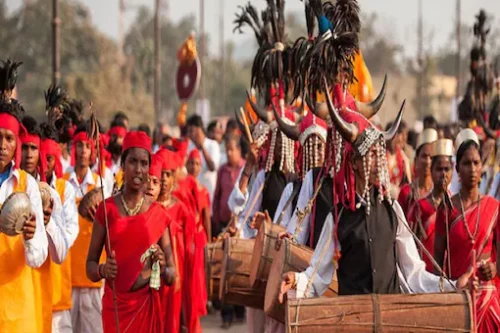
The Bastar Dussehra is a unique festival and has no relation to Ramayana or Rama. It is celebrated by tribals for 75 days and is the longest festival in the world. During these days, many rituals are performed. There are as many as 12 main events that are performed from July to October. Even so, the last 10 days, which coincide with Navarathri, are the most special period. The 10-day festival starts with Kaachan Gadi Puja and ends with the Baahar Raini. The festivities take place in Jagdalpur in the Bastar region of Chattisgarh and hence, this festival is also called Jagdalpur Dussehra. Each caste and tribe has a specific function and this was started way back in the 13th century. It is celebrated to get the blessings of Goddess Danteswari, who is revered among the many tribes of Chhattisgarh.
India is known for its diversity and the same applies even to festivities celebrated here. Dussehra, the festival of victory of good over evil, is a classic example of it. Though the significance remains the same, which is good winning over evil, the elements and the way it is celebrated are similar yet unique. With Dussehra being a holiday season, it is also a great time to travel to one of the above places and see it with your own eyes.
If you are interested in knowing more about the different celebrations for the Hindu New year, you can read that too!
Have you seen any of the above celebrations? Let us know your observations in the comments below.

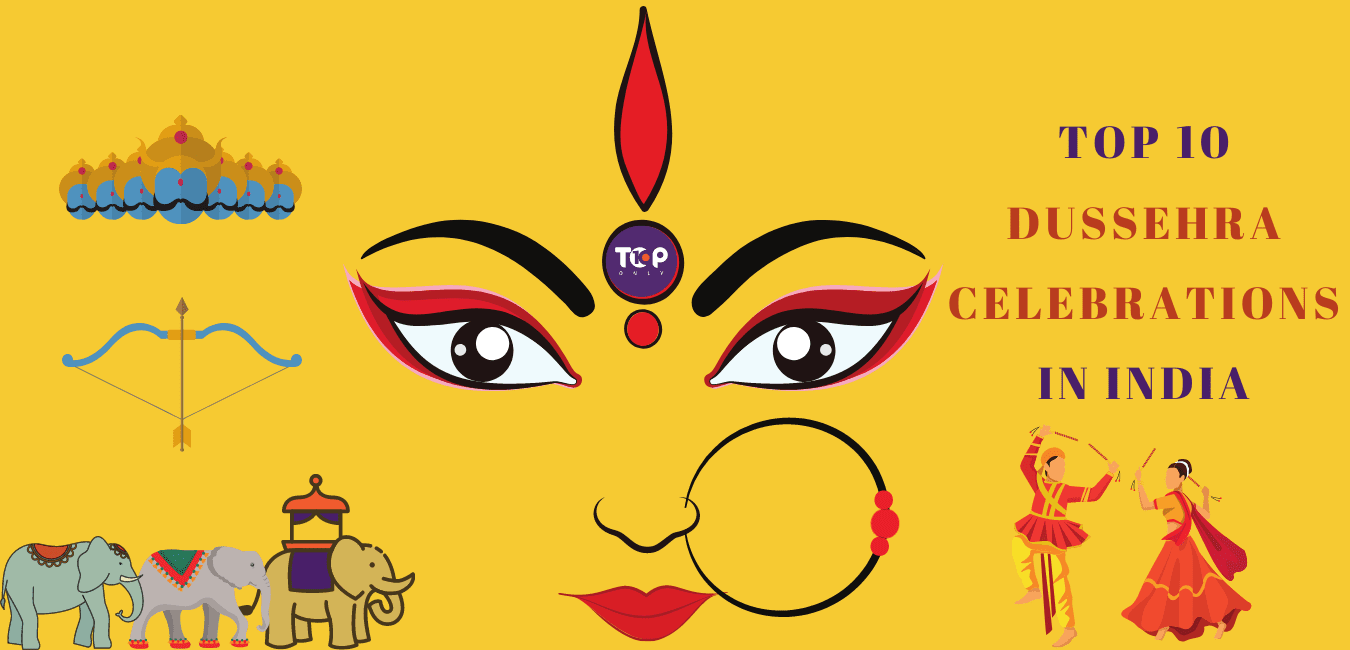
Pingback:Top 10 Significance of Day 1 of Navarathri | Shailaputri | Top 10s Only
Pingback:Happy Diwali 2022 | Significance of Diwali Festival | Top 10s Only
Pingback:Top 10 Most Magnificent Royal Palaces Of India | Top 10s Only